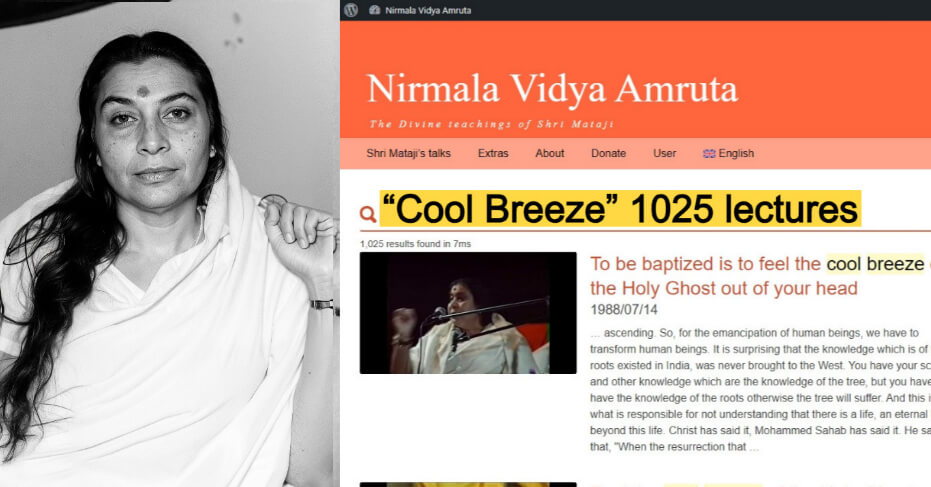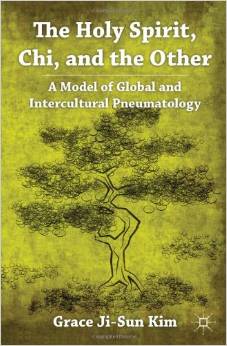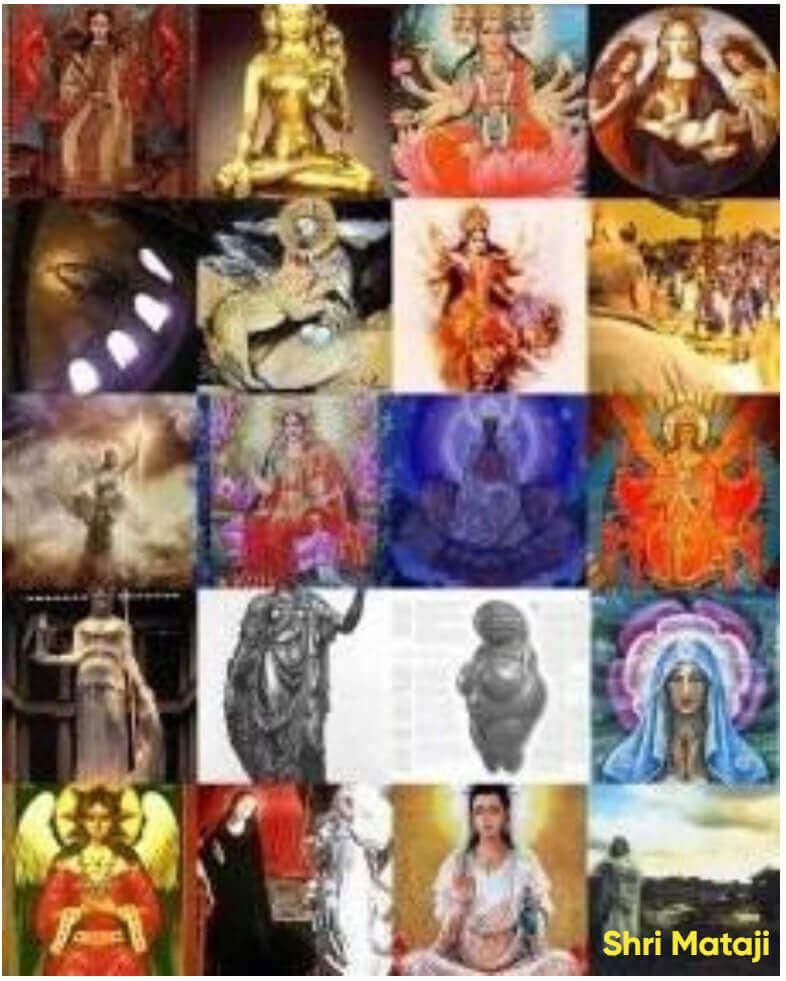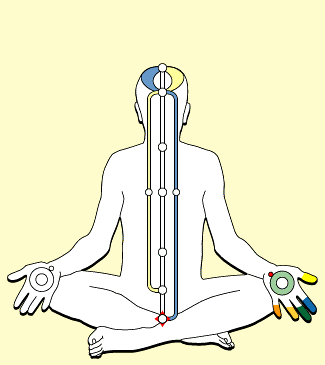Chi-Divine and Universal
Chi Divine and Universal
affirms Chi as the omnipresent Spirit sustaining all creation, resonating with the Sanskrit concept of prana in yoga, meaning life energy
or breath.
Shakti, the divine feminine and the power or energy of God, is revealed as the source of prana, the origin of all vital force. This page explores Taoist, Hindu, and universal metaphysics to show how Chi, prana, and Shakti converge as expressions of the same salvific Spirit, awakening consciousness and guiding humanity toward Self-realization and collective transformation.

Across cultures and eras, humanity has used different terms—Shakti, prana, and chi—to describe the same vital, divine force that animates the cosmos and the individual. Though emerging from distinct traditions, these concepts point to a single universal energy that is both sacred and experiential. Shri Mataji Nirmala Devi identifies this very force as the Cool Breeze felt at the awakening of the Kundalini, revealing it as a tangible, verifiable manifestation of the Divine Feminine. This experience fulfills the deeper meanings of the Dasvaa Duar in Sikhism and Jesus' teaching on being born of the Spirit,
offering a unified, cross-scriptural path to liberation and eternal life.

Chi-Divine and Universal
The world is becoming more and more globalized, resulting in local cultures that are increasingly multireligious, multilingual, and multicultural. In this context, it is important to recognize the differences between people and the similarities among cultures and religions. This world is filled by the Spirit and the Spirit needs to be recognized by people of various cultures. Besides ruach, pneuma, and Chi, there are other terminologies in various cultures that also capture this idea of Spirit/ Breath of God. As we examine the religions found in different parts of the world, we do not find many spirits; we find various names for the Spirit.
Let us turn to other understandings of the Spirit around the globe to see if they share similarities with ruach and Chi. The West has typically given into structure (and to essentialist forms of thought) while Eastern thought- and this is a broad generalization, to be sure- typically thinks more in terms of vitality, energy, and relation. For example, perhaps a reason Westerners often find texts like the Analects of Confucius difficult to read is that such works often posit connections between things that the Western mind usually views as separate and unrelated.
This notion of the Spirit giving life to creatures is not exclusively a Christian belief and understanding but is found in many other cultures around the globe. Associating Spirit with breath is common and is found in many parts of the world. The breath of life was interpreted by the ancients as the act of breathing, which indicates life. Genesis 2: 7 gives the following account of God creating man: "Then the Lord God formed man of the dust of the earth, and blew into his nostrils the breath of life; and man became a living soul.” The connection between human life and the breath of God, as viewed in the Bible, may have roots tracing back to the cradles of civilization in Egypt and Mesopotamia. Many inscriptions from ancient Babylon attest to the deity being the source of the Spirit that gives life to humankind. This Spirit of life is exhaled from the deity's mouth into other creatures in order to give them life. An ancient Sumerian-Akkadian hymn addresses the god Marduk with the words: "Your speech is a sweet breath, the life of the lands.” 51 Thus perhaps the Christian tradition finds it roots in Egypt and Mesopotamia, which makes us question the purity of the Christian tradition and whether there was borrowing of religious and divine terms from surrounding religious traditions and cultures.
Chi is the cosmic energy that is present in the world and is mentioned or captured in the majority of world religions. It is in the realm of this Spirit that all religions open themselves and reach out to be related to other religions. Spirit is the foundational and transcendental level on which all religions could meet and remain related. To the extent of our capacity to experience the Spirit, we can be authentic followers of the religion of our choice and practice. 52 The religions all lead to the Divine and we need to understand that the Spirit in each is from the same source- God. Chi is everywhere. It dwells in everything in the universe.
Chi as Sacred
Many ethnic groups have concepts similar to Chi thus making connections between Chi and the Divine or sacred. The Egyptians call it Ka, the Hebrew have ruach, the Japanese have ki, 53 the Indians call it prana, and the Igbos of Nigeria call it Chi. 54 For the Igbos , Chi is best translated as "god,""guardian spirit," "God," or allied theistic concepts. In the sense of God, as in Christianity, some of the exponents claim that Chi is synonymous with Chukwu and Chineke, which are presented as identical accurate Igbo denotations for the "Supreme Being.” 55 Just as the Christian God is understood as the Spirit, many cultures and religions also link Chi to the Divine.
There is an underlying understanding that the Spirit is connected to or is the Divine in many religions and cultures. An indigenous religion that is common to many colonized people is shamanism. Shamanism is found in almost every continent as the oldest religion. It speaks untold truths and has been a means of spirituality, of connecting with the spirit world. Primordial shamanistic Chi existed in relation to animistic polytheism, worshipping wind, cloud, tree, and other natural phenomena. 56
The shaman is often mythologized by Western thinkers as a necessarily culturally conservative figure of indigenous societies. Shamanism remains essential as an indigenous preserver of cultural tradition in many forms. Shamans have been viewed as resisters to Christian influence, as upholders of unchanged traditions, and as an obstacle to biomedicine and medical "progress.” Often, Westerners view shamanism as a static cultural form. 57
The concept of Chi is not limited to Asia, but is also found in many parts of the world. In the Western tradition, the idea of Chi has a long history and can be traced to the sixth century BCE when Anaximenes of Miletus taught that everything emerges from breath that condenses into matter and finally all things dissolve back into breath-like energy again. This cosmic energy has resurfaced from time to time in Europe. In the eighteenth century, Franz Mesmer claimed to utilize what he called "Animal magnetism.” In the following century, Karl von Reichenbach spoke of the "odic force," and in the twentieth century Wilhelm Reich professed to harness "orgone energy.” The idea of a universal cosmic energy that creates and destroys still lives on in the popular consciousness of Britain. 58
Similar expressions of the Spirit are also found in Akkadian literature: "May your sweet breath waft hither," or "Always seek the sweet breath of the gods.” These close parallels come from the El-Amarna letters, in a phrase actually addressed to the king: "[Who can live] when breath does not issue forth from the mouth of the king, his lord?” 59 Furthermore, similar views are found in ancient Egypt in praise of Isis coming with her tremendous powers including that of speech, which is perceived as the life-giving breath of the deity of humankind. A more striking illustration is provided by the words of the Egyptian king's addresses to the god Amon: "Your color is light, your breath is life.... your body is a breath of spirit for every nostril, we breathe through you in order to live.” 60 This common notion of the deity giving breath and life may have been a common understanding in various religious traditions surrounding the cultural forerunners of the Abrahamic faiths.
The Breath of God (Ruach Ha Kodesh in Hebrew, Spiritus Sancti in Latin) is synonymous with the power of Spirit. A similar idea is expressed in the holy scripture of Islam, the Qur'an (Koran). The words nafas, meaning Allah's own breath, and ruh, meaning Allah's own soul, "Are used to mean the human breath and human soul- confirming the fact that we are originally from Allah, of Allah, for Allah, and in the end will return to Allah.” 61 Shaykh Hakim Moinuddin Chishti says that "Breath" is not the same as air or oxygen. Rather it is a divine energy that regulates human emotions and the equilibrium of the body; both the quantity and quality of breath have a definite and direct effect upon human health. 62 This connection of Spirit, breath, and Allah provide more evidence of a global understanding of the Spirit.
In Greek, the vital breath is called pneuma, a word first used by the philosopher Anaximenes (ca. 545 BCE). Anaximenes said that life begins with the breath. All things come from it and dissolve into it at death. The soul is breath and is that which controls and "holds together" and prevents the disintegration or decomposition of human beings. As air or wind, it encloses and maintains the world. Vital breath creates a unity between microcosm and macrocosm. The life principle and motive force of humanity is, traditionally, pneuma or the breath-soul: therefore the life principle of the outside world is pneuma. 63
In many African cultures, the word is different, but the concept is the same. Among the Kung San, the indigenous people of Africa's Kalahari Desert, life energy is num. The num is stored in the lower abdomen and at the base of the spine and can be made to "Boil" though ecstatic dance. The "num enters every part of your body, right to the tip of your feet and even your hair.” 64 Num makes the spine tingle and the mind empty, without thoughts. The healer or healers "see people properly, just as they are.” 65 Like modern physicians, the Kung believe that people carry illness within the body. Like Chi, when disease flares up, it can sometimes be cured by accumulating num, increasing the inner reserve of healing power. 66 This reinforces the notion that healing occurs within as people aim to understand how the Divine resides within us. People need to make the connection and understand that the healing power can come from within us through the deity.
In Tantrism, a practice of using the body for spiritual transformation found in Buddhism and Hinduism, "The body, the earth, nature, etc., are associated with the divine feminine, with shakti, and the aim is to unite it, or bring it into harmony with consciousness, with shiva, the male principle.” 67 Shakti is the power or energy of God, the divine feminine. The equivalent of Chi in yoga is the Sanskrit term prana, which means "life energy" or "Breath.” Shakti would be the source of prana. Within Taoism, Chi will not be called Divine per se, because Divine implies a certain otherness in the universe. Taoists only acknowledge Tao, which is at once the universe and at the same time what composes the universe, Chi. 68 Hindus speak of the Divine, surging, mothering energy as Shakti. Shakti is the feminine aspect of God and the word means "energy" or "power.” It is not the power of the female in particular. It is all divine power and energy, and it is conventionally said to be an attribute of the Goddess. In Sanskrit and Hindi, the root of Shakti is the helping verb that means "to be able.” The energy to do anything is Shakti. In the theological realm, when one speaks of the kinetic energy of God in the world, nourishing , enabling, kindling, breathing, moving in life and in death-this is Shakti.
The ancient seekers and sages of the Upanishads were relentless questioners, exploring the limits of both outer and inner space. Who are we human beings, really? Really we are atman, the soul. The word atman also means "Breath," but not literally the breath of respiration. That is called prana, a coarser breath. The awareness of prana, however, is but a vehicle for the realization of atman. Breath, prana, is a powerful image of the spark of life within, for truly when breath departs we die. Living beings are called prani, literally "those who breathe.” Prana is so important that it is explicitly and provocatively set side by side with atman in the Kaushitaki Upanishad: "I am the breathing spirit [prana], the intelligential self [prajnatman]. As such, revere me as life, as immortality. Life is the breathing spirit. The breathing spirit, verily, is life. The breathing spirit, indeed, is immortality. For, as long as the breathing spirit remains in this body, so long there is life" (3: 2). 69
In India, the life energy, prana, is described as flowing through thousands of subtle-energy veins, the nadis. One of the goals of yoga is to accumulate more prana through breath control exercises (pranayama) and physical postures (asana). The student is also taught to conserve prana, not to waste either his inborn, genetic store or that acquired through meditation. Some yogis believe that we are given a certain number of breaths at birth. If we learn to breathe more slowly, we use up our endowment at a slower pace and thus live longer. Furthermore, some fifty or sixty thousand years ago, long before the Chinese spoke of Chi, Australian Aborigines were cultivating life energy as a key to healing and spiritual power. People who had this energy could communicate telepathically across vast distances and in this manner, they formed the "Aboriginal telephone line.” The Aborigines concentrated on an energy center four inches below the navel, where they said the cord of the great Rainbow Serpent (kundalini) lay coiled. Through the same center the Aborigines drew body heat from the "rainbow fires" that helped them endure cold. 70
In the Lakota (Sioux) language, the word for soul, waniya, is derived from the word for breath, ni. In 1896, the Lakota holy man Long Knife (George Sword) described to others that “A man's ni is his life. It is the same as his breath. It gives him his strength. All that is inside a man's body it keeps clean. If it is weak it cannot clean the inside of the body. If it goes away from a man he is dead.” 71 The Lakota sweat lodge healing rite is called inipi because it purifies the ni. "Inipi causes a man's ni to put out of his body all that makes him tired, or all that causes disease, or all that causes him to think wrong.” 72 Inipi is a purifying process that gets rid of the unnecessary ni to make the person stronger and healthier. This is similar to the role of Chi, as ni is understood to give life and health.
The Japanese also have a similar term and call this energy ki. This ki is part of other words such as reiki and aikido, which readily deal with this energy. Very often this energy is connected in the external world with wind and internally with breath. In Hawaii, the word for breath is ha. Many visitors to Hawaii are presented with a flowery wreath and the greeting Aloha, which is translated, "meeting face to face (alo) of the breath of life (ha).” 73 This is the same kind of breath that is captured by the Chinese word Chi.
Chi is believed to be the energy that is connected in the external world with wind and internally with breath. For thousands of years this wind has formed the physical and spiritual life of the peoples of the Pacific. The wind in Hawaii almost always blows from the East, and is strong, steady, and insistent. The ancient Hawaiians called it ha, the breath of God, which is very similar to the Old Testament understanding of ruach, which is breath or God's breath. In Hawaiian mythology, wind heralded Lono, the god of storm and rain and hence of fertility. Like Ezekiel and Job in the Old Testament, the Pacific peoples have known that God often speaks from the whirlwind. Theirs is a faith shaped by I, a word drawn from two roots combined to mean "In the presence of wind, breath, or spirit.” In Hawaii, to speak of God means necessarily to be open to the often disturbing and life-giving wind of the Spirit. 74 Thus God and Spirit become undeniably connected and intimately related. 75 With aloha, the breath or Chi is given and received during a greeting. This important connection between breath and Spirit is also found within the Christian tradition. God's ruach or breath was given to God's people to give life.
In Hawaii, the most powerful healers are known as Kahuna Ha, "Masters of the Breath.” The sacred healing breath, ha, can be absorbed at power places in nature heiau, through dance (such as the hula), and deep breathing exercises. Some Kahunas learn to store healing energy in the heart. Then, when the healing energy is projected through laying on of hands, the ha is colored by the healer's love and positive thoughts. In traditional Hawaiian counseling and mediation, all parties in a conflict first calm their minds by breathing deeply. This helps them to be less reactive and to find a better solution. The ha can also be transferred from a healer to a patient by blowing directly on the patient's body. When a Kahuna Ha is near death, he or she may transfer lineage and power by breathing the ha onto a student or family member. The Hawaiian word, aloha, which is often used as a respectful, heartfelt greeting, also means "love.” Love is the "meeting face-to-face" (alo) of the breath of life (ha). 76 Many cultures have words to express the similar ideas of breath, life, and vital energy that are expressed by the Christian understanding of the Holy Spirit and the Chinese understanding of Chi. So is it one Spirit or many?
Kim, Grace Ji-Sun (2011-09-20). The Holy Spirit, Chi, and the Other (p. 23-28). Palgrave Macmillan Monographs. Kindle Edition.
Notes
50 . Lee, The I Ching and Modern Man, 93.
51 . Admiel Kosman, "Breath, Kiss and Speech as the Source of the Animation of Life: Ancient Foundations of Rabbinic Homilies on the Giving of the Torah as the Kiss of God," in Self, Soul and Body in Religious Experience, ed. A.I. Baumgarten, J. Assmann, and G.G. Stroumsa Leiden, The Netherlands: Brill, (1998), 100.
52 . Joseph Pathrapankal, "Editorial," Journal of Dharma 23, no. 3 (1998): 300.
53 . Nikem L. Emeghara, "The Igbo Concept of Chi: The Destiny Spirit," Journal of Dharma 23 (1998): 399.
54 . Cook , "Alternative and Complementary Theologies," 176.
55 . I. Chukwukere, "Chi in Igbo Religion and Thought: The God in Every Man," Anthropos 78 (1983): 520.
56 . Shin, "The Life-Giving Spirit," 96.
57 . Shane Greene, "The Shaman's Needle: Development, Shamanic Agency and Intermedicality in Aguaruna Lands, Peru," American Ethnologist 25, no. 4 (1998): 9.
58 . Cook , "Alternative and Complementary Theologies," 176.
59 . Kosman , "Breath, Kiss and Speech as the Source of the Animation of Life," 101.
60 . Ibid., 101.
61 . Shaykh Hakim Moinuddin Chishti, The Book of Sufi Healing Rochester, VT: Inner Traditions , (1991), 123 as quoted by Kenneth S. Cohen, The Way of Qigong: The Art and Science of Chinese Energy Healing New York: Ballantine Books, (1997), 23.
62 . Cohen, The Way of Qigong, 23.
63 . Ibid., 24.
64 . Richard Katz, Boiling Energy Cambridge, MA: Harvard University Press, (1966), 42.
65 . Ibid., 42.
66 . Cohen, The Way of Qigong, 24.
67 . Wayne Teasdale, Toward a Christian Vedanta: The Encounter of Hinduism and Christianity According to Bede Griffiths Bangalore, India: Asian Trading Corporation, (1987), 147.
68 . Bede Bidlack, "Qi in the Christian Tradition," Dialogue and Alliance 17, no. 1 (2003): 53.
69 . Diana L. Eck, Encountering God: A Spiritual Journey from Bozeman to Banaras Boston: Beacon Press, (1993), 123, 124.
70 . Cohen, The Way of Qigong, 25, 26.
71 . James R. Walker, Lakota Belief and Ritual Lincoln: University of Nebraska Press, (1980), 83.
72 . Ibid., 83- 84.
73 . Cook , "Alternative and Complementary Theologies," 176.
74 . Belden C. Lane, "The Breath of God: A Primer in Pacific/ Asian Theology," Christian Century, 107 no. 26 (1990): 833.
75 . Cook, "Alternative and Complementary Theologies," 176.
76 . Cohen, The Way of Qigong, 26.
Shakti, Prana, and Chi as the Universal Cool Breeze of Spiritual Liberation
Author: Manus AI
Abstract
This paper conducts a comparative theological analysis of the concepts of Shakti in Hinduism, prana in yogic traditions, and Chi in Taoism, positing that these terms describe a singular, universal divine energy. It argues that this divine feminine power is not merely a theoretical construct but an experiential reality, identified by Shri Mataji Nirmala Devi as the Cool Breeze—a tangible manifestation of Kundalini awakening. By examining parallels in Sikhism's Dasvaa Duar (Tenth Gate) and Christianity's doctrine of being "born of the Spirit," this paper asserts that the direct experience of this divine current is the key to achieving moksa (liberation) and the eternal life promised across the major scriptures of the world. It emphatically declares that this inner awakening, centered on the Divine Feminine, offers a universal and verifiable path to spiritual transcendence.
Table of Contents
- 1. Introduction: The Universal Quest for Divine Energy
- 2. Shakti: The Primordial Divine Feminine Power
- 3. Prana and Chi: The Breath of Life Across Cultures
- 4. The Cool Breeze: Experiencing the Divine Within
- 5. Comparative Pneumatology: Dasvaa Duar and Being "Born of the Spirit"
- 6. Moksa and Eternal Life: The Ultimate Promise
- 7. Conclusion: The Unifying Experience of the Divine Feminine
- 8. References
1. Introduction: The Universal Quest for Divine Energy
Across civilizations and epochs, humanity has sought to comprehend the vital force that animates the cosmos and the individual. This quest has produced a rich tapestry of spiritual vocabularies attempting to name the unnamable. In Hinduism, this kinetic, creative power is known as Shakti, the Divine Feminine [1]. In the yogic sciences of India, its subtle manifestation in the body is prana, the life-breath [2]. In Taoist philosophy, it is the Chi, the cosmic energy that flows through all things [3]. While these terms arise from distinct cultural and linguistic contexts, they point toward a singular, underlying reality: a universal current of divine energy. This paper argues that these concepts are not merely analogous but are identical in their essential nature. Furthermore, it posits that this energy is not an abstract principle but an experiential phenomenon, identified in the modern era by Shri Mataji Nirmala Devi as the Cool Breeze—the tangible, vibratory sensation felt upon the awakening of the indwelling spiritual energy known as Kundalini [4]. This experience, this actualization of the divine connection, represents the opening of the Dasvaa Duar (Tenth Gate) in Sikhism and the true meaning of being "born of the Spirit" in Christianity. It is this direct perception of the Divine Feminine within that fulfills the scriptural promises of moksa (liberation) and eternal life, offering a universal and verifiable path to spiritual fulfillment.
2. Shakti: The Primordial Divine Feminine Power
In the vast theological landscape of Hinduism, Shakti represents the active, dynamic, and creative power of the Godhead. The term itself, derived from the Sanskrit root shak ("to be able"), signifies power, energy, and ability [5]. Shakti is the Divine Feminine, the Great Mother, the matrix of all existence. She is not merely a consort to a male deity but the kinetic energy of God in the world, responsible for all creation, sustenance, and transformation. As one source explains:
In the theological realm, when one speaks of the kinetic energy of God in the world, nourishing, enabling, kindling, breathing, moving in life and in death—this is Shakti.[1]This divine power is not an external force but the very source of individual life. In the microcosm of the human body, Shakti manifests as Kundalini, a potent, dormant energy coiled at the base of the spine. The awakening of this inner Shakti is the central goal of many yogic and tantric paths, as it is this energy that purifies the subtle system and leads to higher states of consciousness. Crucially, Shakti is understood to be the ultimate source of prana, the life-energy that sustains all living beings. Without Shakti, there is no movement, no life, no consciousness.
3. Prana and Chi: The Breath of Life Across Cultures
The concept of a vital life force, synonymous with breath, is a remarkably consistent theme across global spiritual traditions. In India, this is prana. The Upanishads, ancient texts of Hindu philosophy, provocatively equate prana with the very essence of life and immortality [2]. Yogic practices such as pranayama (breath control) are designed to accumulate and direct this subtle energy to enhance vitality and spiritual awareness. In Taoism and Chinese culture, this same universal energy is called Chi (or qi). It is the cosmic force that constitutes and animates all things in the universe [3]. The parallels do not end there. A comparative survey reveals a global consensus on this "breath of God":
- In Hebrew, it is ruach, the spirit or wind of God that moved over the waters at creation (Genesis 1:2) [6].
- In Greek, it is pneuma, the vital breath or wind that Jesus used to describe the nature of the Spirit (John 3:8) [7].
- In Arabic, it is ruh, the soul or breath of Allah [8].
- In Japanese, it is ki, central to practices like Reiki and Aikido [3].
- In the Lakota (Sioux) tradition, it is ni, the life-giving breath purified in the sweat lodge [9].
This striking convergence suggests that ancient cultures, through intuitive and mystical insight, all perceived the same fundamental reality: a divine, life-giving energy that is inextricably linked with breath and spirit. Shakti is the primordial source, while prana and Chi are its expressions, the very currency of life.
4. The Cool Breeze: Experiencing the Divine Within
While ancient scriptures and traditions describe this divine energy, Shri Mataji Nirmala Devi (1923-2011), the founder of Sahaja Yoga, made the radical declaration that this power can be tangibly experienced in the modern age. She identified this experience as a Cool Breeze felt on the central nervous system, specifically on the palms of the hands and above the head, at the fontanelle bone area [4]. This, she explained, is the empirical evidence of Kundalini awakening.
When the Kundalini rises, then from the fontanelle bone area you feel a cool breeze coming out—this is the cool breeze of the Holy Ghost. ... This is the actualization of the baptism.[10]According to Shri Mataji, this Cool Breeze is not a metaphor but a direct perception of the All-Pervading Power of Divine Love, the same power described as ruach, pneuma, prana, and Chi. It is the objective, verifiable sign that the individual spirit has connected with the universal Spirit. This experience is characterized by a state of thoughtless awareness (nirvichara samadhi), profound peace, and a feeling of centeredness and joy. Sociological studies of Sahaja Yoga practitioners have documented this phenomenon, noting that individuals report feeling "a strong Cool Breeze," "incredibly peaceful," and entering a "timeless" state [11]. Therefore, the Cool Breeze demystifies spirituality, transforming it from a subject of belief into a living, perceptible reality.
5. Comparative Pneumatology: Dasvaa Duar and Being "Born of the Spirit"
The experience of the Cool Breeze, as the culmination of Kundalini's ascent through the crown chakra (Sahasrara), finds profound resonance in the mystical traditions of other world religions.
In Sikhism, the Guru Granth Sahib speaks of the human body having nine gates (eyes, ears, etc.) that lead outward, but a hidden tenth gate, the Dasvaa Duar, which opens inward to the abode of God [12]. The opening of this gate, located at the crown of the head, is not achieved by force but by the grace of the Guru and the meditation on the divine Name (Naam). When it opens, the devotee experiences the unstruck melody (Anahad Shabad) and the flow of divine nectar (amrit), leading to liberation while living (jivanmukti). This directly corresponds to the Kundalini piercing the Sahasrara chakra, resulting in the Cool Breeze and the state of divine union.
In Christianity, Jesus Christ tells Nicodemus that to enter the kingdom of God, one "must be born again... born of water and the Spirit" (John 3:3-5). When Nicodemus expresses confusion, Jesus explains:
The wind (pneuma) blows where it wishes, and you hear its sound, but you do not know where it comes from or where it is going. So it is with everyone born of the Spirit.(John 3:8) [7]Shri Mataji identifies this mysterious "wind" or "breath" (pneuma) with the Cool Breeze. Being "born of the Spirit" is not a mere intellectual assent or a ritual act, but the actual, experiential event of Kundalini awakening, where one can feel the Spirit as a cool, silent wind. This interpretation gives profound, empirical meaning to Christ's words, suggesting that the experience of the Holy Spirit was always meant to be a tangible reality, not just a matter of faith. The early Syriac Christian tradition further supports this by referring to the Holy Spirit (Ruha) with a grammatically feminine noun, even describing the Spirit as "Mother" [13], aligning perfectly with the concept of the Divine Feminine power of Shakti.
6. Moksa and Eternal Life: The Ultimate Promise
The ultimate promise of all major world scriptures is liberation from suffering and the attainment of an eternal, divine state. In Hinduism, this is moksa—release from the cycle of birth, death, and rebirth (samsara) [14]. In Christianity and Islam, it is the promise of eternal life in the Kingdom of God or Paradise [15]. This paper emphatically declares that the experience of the Cool Breeze and the subsequent state of meditative awareness on the Divine Feminine within is the direct mechanism for achieving this promised state.
By establishing a connection with the universal divine energy, the individual consciousness is cleansed and transformed. The ego and conditionings that create a sense of separation and lead to suffering begin to dissolve in the state of thoughtless awareness. This inner purification and union with the Spirit is the very definition of moksa. It is not a posthumous reward but a living reality—jivanmukti—a state of freedom, joy, and divine knowledge experienced in the present moment. The promise of "eternal life" is thus understood not as an infinite duration of time, but as an entry into the timeless dimension of the Spirit, a state accessible here and now through the awakening of the divine power within. This awakening, verified by the Cool Breeze, is the fulfillment of the scriptural promise, the true resurrection and the entry into the Kingdom of God that lies within.
7. Conclusion: The Unifying Experience of the Divine Feminine
The theological concepts of Shakti, prana, and Chi are not disparate ideas from isolated cultures but are, in fact, different names for the same universal, divine, and fundamentally feminine energy that is the substratum of all existence. Shri Mataji Nirmala Devi's teaching of the Cool Breeze provides the crucial hermeneutic key, transforming these concepts from philosophical abstractions into a verifiable, experiential reality. The tangible sensation of the Cool Breeze is the empirical proof of Kundalini awakening, the opening of the Dasvaa Duar, and the true baptism of being "born of the Spirit."
This direct experience of the Divine Feminine within is the unifying thread that runs through the mystical core of all world religions. It transcends dogma, ritual, and cultural boundaries, offering a direct path to the spiritual liberation promised in every major scripture. The meditation on this inner divine energy leads to moksa and eternal life, not as a future hope, but as a present, living reality. The Cool Breeze is the silent, irrefutable testimony that the Kingdom of God is within, and its gates are open to all who sincerely seek to know their own spirit.
8. References
[1] Kim, Grace Ji-Sun. "The Holy Spirit, Chi, and the Other: A Model of Global and Intercultural Pneumatology." Palgrave Macmillan, 2011.
[2] Vanamali. "Shakti: Realm of the Divine Mother." Inner Traditions, 2008, pp. 28-31.
[3] Chia, Mantak. "Healing Light of the Tao: Foundational Practices to Awaken Chi Energy." Inner Traditions, 2008, pp. 32-33.
[4] Shri Mataji Nirmala Devi. "Public Program in Rome, Italy." 8 Sept. 1983. adishakti.org.
[5] Apte, Vaman Shivram. "The Practical Sanskrit-English Dictionary." Motilal Banarsidass Publishers, 1965.
[6] "Genesis 1:2." The Holy Bible, New International Version. Biblica, Inc., 2011.
[7] "John 3:8." The Holy Bible, New International Version. Biblica, Inc., 2011.
[8] Chishti, Shaykh Hakim Moinuddin. "The Book of Sufi Healing." Inner Traditions, 1991.
[9] Sword, George (Long Knife). "Lakota Belief and Ritual." Edited by James R. Walker, University of Nebraska Press, 1980.
[10] Shri Mataji Nirmala Devi. "Talk on Baptism." Nirmala Vidya Amruta, 1982. nirmalavidya.org.
[11] Coney, Judith. "Sahaja Yoga: Socializing Processes in a South Asian New Religious Movement." Curzon Press, 1999, p. 55.
[12] "Dasam Dvar: The Tenth Door." adishakti.org.
[13] Reid, Lucy. "She Changes Everything: A Practical Guide to Finding the Divine Feminine in the Bible." Wild Goose Publications, 2017.
[14] "Moksha." Wikipedia, Wikimedia Foundation, 15 Nov. 2025.
[15] "1 John 2:25." The Holy Bible, New International Version. Biblica, Inc., 2011.
Related Articles:
THE GREAT MOTHER
The Goddess is Supreme Feminine Guru
MahaDevi Research Paper (PDF)
The Supremacy of the MahaDevi Across All Faiths
The Divine Feminine in China
The Indian Religion of Goddess Shakti
The Divine Feminine in Biblical Wisdom Literature
Divine Feminine Unity in Taoism and Hinduism
Shekinah: The Image of the Divine Feminine
The Feminine Spirit: Recapturing the Heart of Scripture
Islam and the Divine Feminine
Tao: The Divine Feminine and the Universal Mother
The Tao as the Divine Mother: Embracing All Things
The Tao of Laozi and the Revelation of the Divine Feminine
Doorway of Mysterious Female ... Within Us All the While
The Eternal Tao and the Doorway of the Mysterious Female
Divine Feminine Remains the Esoteric Heartbeat of Islam
Holy Spirit of Christ Is a Feminine Spirit
Divine Feminine and Spirit: A Profound Analysis of Ruha
The Divine Feminine in Sufism
The Primordial Mother of Humanity: Tao Is Brahman
The Divine Feminine in Sahaja Yoga
Shekinah: She Who Dwells Within
Shekinah Theology and Christian Eschatology
Ricky Hoty, The Divine Mother
Centrality of the Divine Feminine in Sufism
A God Who Needed no Temple
Silence on (your) Self
The Literal Breath of Mother Earth
Prophecy of the 13 Grandmothers
Aurobindo: "If there is to be a future"
The Tao Te Ching and Lalita Sahasranama stand alone
New Millennium Religion Ushered by Divine Feminine
A Comprehensive Comparison of Religions and Gurus



